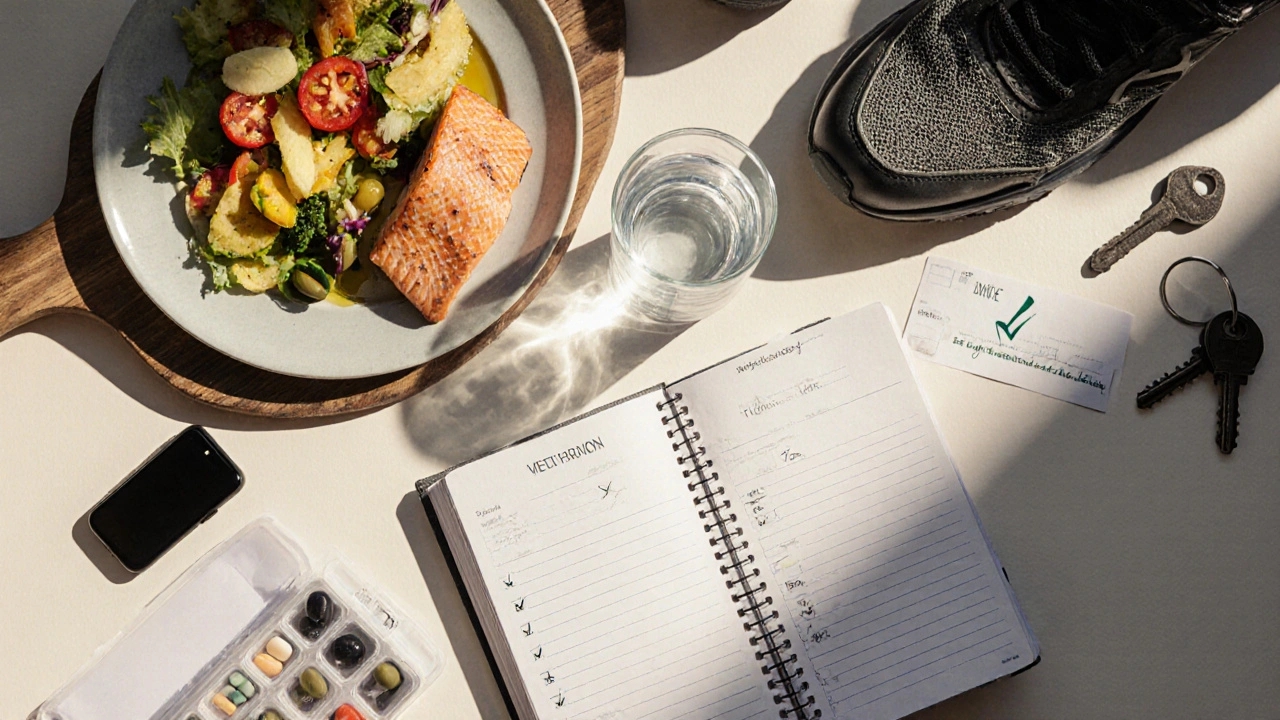Personalized Intermittent Claudication Treatment Plan Builder
Baseline Information
Pain-free walking distance:
LDL Cholesterol:
Smoking Status:
BMI:
Goals
Increase pain-free walking distance:
Lower LDL cholesterol:
Quit smoking:
Core Therapies
Walking Program
Weekly Sessions:
Session Duration:
Location:
Medication Plan
Statins:
Antiplatelet Agent:
ACE Inhibitor:
When leg pain pops up while walking, it’s often a sign of intermittent claudication, a common symptom of peripheral artery disease (PAD). Instead of accepting the pain as inevitable, you can design a personalized intermittent claudication treatment plan that blends exercise, medication, diet and regular monitoring. Below is a hands‑on roadmap that walks you through every step, from assessing risk to tweaking the program as you improve.
1. Assess Your Baseline - Know Where You Start
Before you can tailor anything, you need a clear picture of your current health. The key data points are:
- Walking distance before pain begins (usually measured in a treadmill test).
- Blood pressure, cholesterol, blood sugar levels.
- Smoking status and body‑mass index (BMI).
- Existing medications and any past vascular procedures.
Ask your clinician for a vascular imaging study-ultrasound, CT angiography or MR angiography-to see where arteries are narrowed. This visual map becomes the backbone of your risk‑factor assessment.
2. Set Realistic Goals - What Success Looks Like
Goal‑setting keeps you motivated and gives your clinician measurable targets. Typical aims include:
- Increase pain‑free walking distance by 20‑30% in three months.
- Lower LDL cholesterol below 2.5mmol/L.
- Quit smoking within six weeks.
Write these goals down, attach a deadline, and review them monthly. If you’re unsure, use the SMART framework (Specific, Measurable, Achievable, Relevant, Time‑bound) to sharpen each objective.
3. Choose Core Therapies - The Pillars of Your Plan
Research shows that a combination of lifestyle changes and medication works best. Here’s a quick snapshot:
| Therapy | Primary Benefit | Typical Dose/Regimen | Key Considerations |
|---|---|---|---|
| Exercise Therapy | Improves blood flow and muscle efficiency | 3‑5 sessions/week, 30‑45min walking | Progress gradually; monitor pain level |
| Pharmacological Therapy | Reduces clot formation and dilates vessels | Statin daily, antiplatelet (e.g., aspirin 75mg) | Check liver function; watch for GI upset |
| Nutritional Counseling | Controls cholesterol, weight, inflammation | Mediterranean‑style diet, 1500‑1800kcal | Track sodium; limit saturated fats |
| Revascularisation (if needed) | Restores blood flow in severe blockages | Angioplasty or bypass surgery | Invasive; reserved for refractory cases |
Most people start with Exercise Therapy and Pharmacological Therapy. Nutrition and smoking cessation support those efforts, while revascularisation is a backup when symptoms don’t improve after six months of conservative care.
4. Build Your Supervised Walking Program
A supervised walking program is the heart of exercise therapy. Here’s how to set one up:
- Pick a safe location - a flat track, treadmill, or a park path with even ground.
- Warm‑up - 5 minutes of slow walking or gentle leg swings.
- Interval walking - Walk until moderate leg pain appears (5‑7minutes), then rest or reduce speed until the pain eases. Repeat 3‑5 times.
- Cool‑down - 5 minutes of easy walking, followed by calf and hamstring stretches.
- Log each session - Note distance, pain score (0‑10), and rest intervals. Apps like My PAD Coach or a simple spreadsheet work well.
Gradually increase the walking time by 1‑2minutes each week. After three months, many patients can walk 30‑40% farther without pain.

5. Fine‑Tune Medication - What to Discuss With Your Doctor
Medication is a teammate, not a solo hero. Typical prescriptions include:
- Statins (e.g., atorvastatin 20mg daily) to lower LDL and stabilise plaques.
- Antiplatelet agents such as low‑dose aspirin or clopidogrel to prevent clots.
- ACE inhibitors (e.g., ramipril) if you have hypertension or diabetes, as they improve endothelial function.
Ask your clinician about side‑effects, blood‑test intervals, and whether a combination therapy is needed. Adjustments are common-if muscle aches develop on a statin, a lower dose or a different statin may help.
6. Nutrition and Lifestyle - Fueling Recovery
Food choices directly affect artery health. A practical nutritional counseling plan includes:
- Eat plenty of oily fish (salmon, mackerel) - omega‑3s help reduce inflammation.
- Load up on fruits, veg, whole grains, and legumes for fiber and antioxidants.
- Limit red meat, processed foods, and sugary drinks.
- Keep daily sodium under 1500mg to control blood pressure.
- Stay hydrated - aim for 2L of water a day, especially during walks.
Pair meals with a short post‑dinner walk (10‑15minutes). Even light activity boosts circulation after eating.
7. Track Progress and Adjust - The Feedback Loop
Every four weeks, sit down with your clinician (or a trained physiotherapist) and review:
- Walking logs - have you hit the distance target?
- Blood work - cholesterol, HbA1c, kidney function.
- Medication side‑effects - any new symptoms?
- Lifestyle adherence - smoking, diet, weight.
If progress stalls, consider:
- Increasing walking intensity (steeper incline, faster speed).
- Adding a second antiplatelet agent under specialist supervision.
- Referral for a repeat vascular imaging to evaluate if revascularisation is now appropriate.
Document every change. A simple table in your notebook helps keep the story straight.
8. Common Pitfalls - What to Avoid
Even a well‑designed plan can go off‑track. Watch out for:
- Skipping pain reviews - ignoring worsening pain can mask disease progression.
- Overdoing the walk - aiming for “no pain” too quickly may cause injury.
- Medication non‑adherence - missing doses erodes the protective effect.
- Unrealistic weight‑loss goals - aim for 0.5kg per week; crash diets hurt energy levels.
When a pitfall appears, pause, reassess, and tweak the component that’s slipping.
Quick Checklist for Your Personalized Plan
- ✅ Complete baseline risk‑factor assessment (imaging + labs).
- ✅ Write SMART goals with deadlines.
- ✅ Enrol in a supervised walking program (or set up a home routine).
- ✅ Start statin and antiplatelet therapy as prescribed.
- ✅ Follow Mediterranean‑style diet and track food intake.
- ✅ Log walking sessions and pain scores weekly.
- ✅ Review progress with a clinician every 4weeks.
- ✅ Adjust exercise intensity, meds, or consider revascularisation if needed.

Frequently Asked Questions
How long does it take to see improvement?
Most people notice a 10‑20% increase in pain‑free walking distance within 6‑8weeks if they stick to the exercise schedule and medication.
Can I do the walking program at home?
Yes. Use a treadmill or a safe, level route. The key is to monitor pain and rest when needed, then repeat the intervals.
What if I smoke and can’t quit right now?
Smoking dramatically speeds disease progression. Even cutting down by half, using nicotine replacement, and scheduling a quit‑date within a month can improve outcomes.
Are there any risks with high‑intensity walking?
The main risk is over‑exertion, which can cause severe pain or injury. That’s why the interval method (walk‑pause‑walk) is recommended - it keeps intensity in a safe zone.
When should I consider revascularisation?
If after 4‑6months of optimal exercise, medication and lifestyle changes you still can’t walk farther than 100m without crippling pain, talk to a vascular surgeon about angioplasty or bypass.
Crafting a personalized intermittent claudication treatment isn’t a one‑size‑fits‑all project. By mapping your starting point, setting clear targets, and mixing proven therapies, you give your legs the chance to move farther and feel better. Keep the checklist close, stay honest in your logs, and treat each weekly review as a chance to fine‑tune the plan. Your legs will thank you.


10 Comments
October 4, 2025 Michelle Morrison
Baseline assessment is the cornerstone of any therapeutic regimen.
October 5, 2025 harold dixon
The step‑by‑step layout really mirrors what we see in clinic when we tailor PAD care. I appreciate the emphasis on SMART goals because they keep patients accountable. Logging distance and pain scores isn’t just busywork; it creates objective data you can show your vascular specialist. Also, the suggestion to start with a flat, even surface reduces the risk of ankle sprains while you’re still building endurance. Mixing in a Mediterranean‑style diet fuels tissue repair and curbs LDL without feeling deprived. Remember to hydrate before and after each walking session – dehydration can falsely amplify claudication pain. Lastly, a quarterly review with your provider makes sure the plan evolves as your vessels heal.
October 7, 2025 Darrin Taylor
One could argue the whole "personalized plan" hype is a pharma ploy to lock patients into lifelong drug regimens. The exercise component alone often suffices if you stick to it religiously.
October 8, 2025 Anthony MEMENTO
When dissecting the architecture of intermittent claudication therapy one must first acknowledge the historical evolution of peripheral arterial disease management. Early twentieth‑century physicians relied solely on surgical bypass without appreciating the metabolic benefits of aerobic conditioning. Modern guidelines incorporate a multimodal algorithm that synergistically reduces ischemic burden. The baseline assessment functions as a diagnostic fulcrum upon which subsequent interventions pivot. Accurate measurement of pain‑free walking distance provides a quantifiable metric for longitudinal analysis. Lipid profiling, particularly LDL quantification, informs statin titration which remains the cornerstone of atherosclerotic risk reduction. Smoking cessation, though often underemphasized, yields a rapid decrement in endothelial dysfunction. Nutritional counseling, especially adoption of a plant‑rich dietary pattern, attenuates systemic inflammation. Exercise therapy, executed via interval walking, induces collateral vessel development through shear stress mediated angiogenesis. Pharmacologic agents such as antiplatelet therapy diminish thrombotic propensity while ACE inhibitors improve arterial compliance. Periodic vascular imaging offers anatomical context to functional improvements. Patient adherence is the most volatile variable and must be reinforced through behavioral coaching. Revascularization is reserved for refractory cases where ischemic thresholds remain unaltered after six months of optimal conservative therapy. The feedback loop consisting of quarterly assessments ensures dynamic adjustment of therapeutic intensity. Ultimately, the integration of these pillars transforms a static disease narrative into a progressive rehabilitation journey.
October 9, 2025 aishwarya venu
That synthesis captures the essence of a holistic approach beautifully. Keep the momentum and celebrate each incremental gain.
October 10, 2025 Nicole Koshen
I noticed the guide recommends a 5‑minute warm‑up but many patients skip it, mistakenly believing it’s optional. Skipping the warm‑up can actually increase the risk of muscle cramps during the walking intervals. Also, the suggested LDL target of below 2.5 mmol/L aligns with current ACC/AHA guidelines for high‑risk patients. If you’re on a statin and experience myalgia, don’t just quit – discuss dose adjustment with your clinician. Finally, tracking your progress in a simple spreadsheet can highlight trends that might be missed in a mental log.
October 11, 2025 Ed Norton
Thanks for the practical tips. I’ll add a warm‑up column to my log and keep an eye on LDL trends.
October 12, 2025 Karen Misakyan
In the grand theatre of vascular medicine the patient’s agency must be accorded a principal role. The confluence of evidence‑based pharmacotherapy and rigorously structured locomotor training constitutes a dialectic of body and science. One must therefore contemplate not merely the mechanics of walking but the metaphysical impetus that propels the individual toward health. To that end, the prescribed Mediterranean dietary regimen serves as a culinary allegory for balance and harmony. Let us, therefore, envisage each step as a deliberate inscription upon the vascular canvas, gradually erasing the vestiges of ischemic shadow.
October 13, 2025 Amy Robbins
Oh sure, because “walking” is the new enlightenment and everyone will achieve nirvana by stepping on a treadmill. Meanwhile, the real world still needs actual medical care, not poetic footnotes.
October 15, 2025 Shriniwas Kumar
From a South Asian perspective the integration of yoga‑based postural sequences can augment peripheral circulation synergistically with the prescribed walking regimen. Moreover, incorporating millet and lentil‑rich dals aligns with the low‑glycemic index recommendations while respecting cultural dietary patterns. It is also advisable to monitor homocysteine levels, especially in populations predisposed to folate deficiency, as this biomarker can influence endothelial function. Finally, community health workers can facilitate adherence by organizing group walks, thereby fostering social support and cultural cohesion.
Write a comment